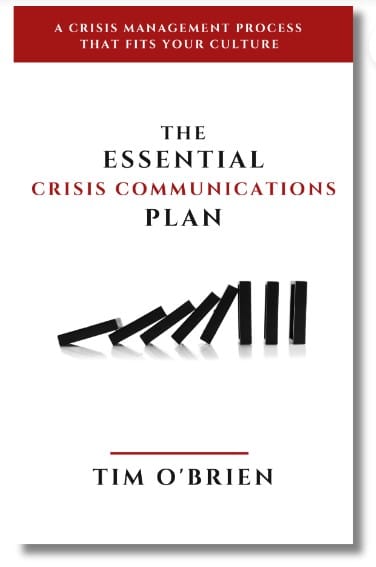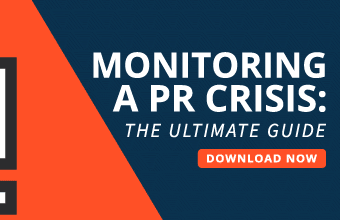The following article is excerpted from the newly published book entitled, The Essential Crisis Communications Plan: A Crisis Management Process that Fits Your Culture:
 In some crisis situations, you may have had the luxury in advance to either obtain opinion or attitude data, or you could even have some of that on file from regular research your organization may already conduct. This kind of benchmark data is valuable after the crisis is behind you when working to determine how effective you are and were at planning for and managing a specific crisis event or issue.
In some crisis situations, you may have had the luxury in advance to either obtain opinion or attitude data, or you could even have some of that on file from regular research your organization may already conduct. This kind of benchmark data is valuable after the crisis is behind you when working to determine how effective you are and were at planning for and managing a specific crisis event or issue.
More often, however, it happens that such data doesn’t exist, or there isn’t enough of it with any specificity to conduct an “apples to apples” post-mortem comparison and analysis.
Still, it is very important for the good of the organization to consider conducting thorough and comprehensive research when the crisis is behind you so that future crisis management efforts benefit. This sort of research can range from secondary research, media coverage analysis, focus groups and surveys, to analysis of news media and social media content and traffic.
The general objective would be to determine how efficient and effective the plan was in execution, where problems may have occurred, and how the organization’s communications outputs may have compared to actual outcomes. More to the point, in the course of the crisis, your team may have had a certain number of meetings, issued a certain number of statements or news releases, hosted a given number of press briefings, distributed a certain number of emails or memos to employees, etc. These are outputs.
The post-mortem analysis process should seek to identify all of these types of data points, and collect them in one place in both detailed and summary form. These data points should be arranged in a few different ways. One may be by category. How many press releases did you generate? But another way would be to list all output activity according to a timeline in chronological order. Tied to this, an overlay on that same timeline should show all of the pivotal events that may have happened throughout the crisis.
With this overlay, you can see how the organization’s outputs tracked with key events in the crisis. You can then see how outcomes took shape. You can determine cause-and-effect, and for that matter, cause-without-effect.
Of course, the complexity and comprehensiveness of such a post-mortem process should be scaled in proper proportion to the severity of the crisis itself. A smaller, well-managed and shorter crisis event like a two-day social media flare-up should not require the same level of post-mortem analysis as a six-month labor strike, for example.
Conducting the Analysis
Once you have all of the critical data in, and once you’ve organized it in an easy-to-review format, you can go about individually, and/or as a Crisis Communications Team to work toward conclusions. In the end, the analysis process is designed to answer the following seven questions:
- What critical follow-up with key stakeholder groups has yet to be conducted?
- What worked?
- What didn’t work?
- What needs to be improved?
- What needs to be preserved or built upon?
- What are the overarching lessons?
- How should our Crisis Communications Plan be modified and adjusted in the wake of this crisis?
Crisis Comms Team Review and Debrief
In fact, these seven questions could form the core agenda of the Crisis Communications Team’s Review and Debrief meeting(s).
Ultimately, you want to create a final document that contains all of the information, data, analysis, conclusions and recommendations for going forward.
Once you’ve gone through this post-mortem process, there is a good chance that changes will need to be made in small or large ways. An organizational policy may need to be changed or introduced. Best-practices and procedures may need to be changed. The crisis communications plan itself may need to be tweaked or changed.
The underlying philosophy of The Essential Crisis Communications Plan is that the plan is a living and breathing document that changes and evolves over time with the organization. After years of using it, your version of the crisis communications plan should look somewhat different than another organization that may have used the same core plan for the same time period. That’s because your organizations are different, your cultures are different, and the challenges you’ve faced and will face are unique to you.
Ongoing Benchmark Research
As mentioned, you may not have had important opinion research going into the crisis event that might have helped during the crisis. You can correct that by building attitude research into your day-to-day operations and communications programs. Such initiatives could include:
- Employee Attitude Research
- Customer/Client Research
- Partner/Vendor Research
- Media Coverage Analysis
- Investor/Analyst Analysis
- Community Attitude Research
- Marketing and Branding Research
- Government and Public Affairs Analysis
Depending on the importance of individual stakeholder groups, a case can be made for keeping your finger on the pulse of their attitudes during non-crisis periods. Not only to help you judge what’s working and what isn’t, but also in the development of key messages in that next crisis. Also, the right kind of ongoing monitoring may indicate the early signs of a smaller, slow-brewing crisis, enabling you to address it before it becomes a big one.








